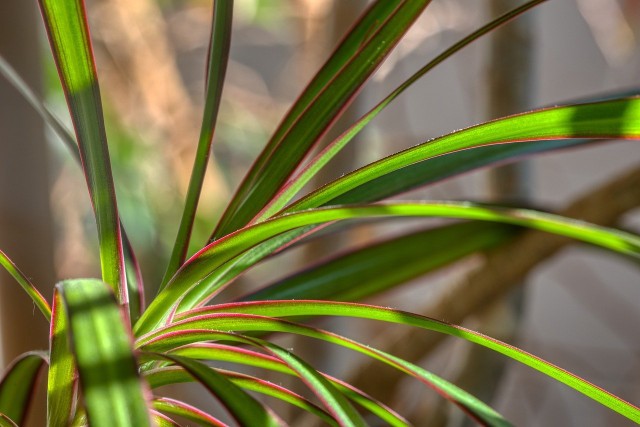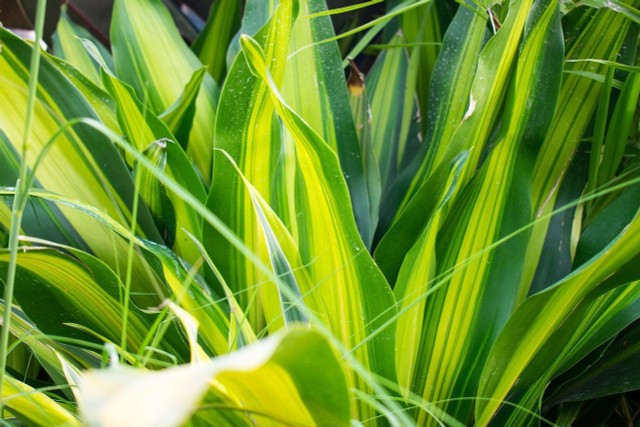
As a houseplant, the dragon tree brings a touch of exoticism into your home. We’ll tell you a few care tips that will help the plant grow especially vigorously.
Its dense, yellow or white-green patterned leaves make the dragon tree a popular indoor and office plant. Also known as dragon palm, the plant naturally grows mainly in tropical and subtropical regions. In our latitudes, the dragon tree also thrives without a tropical climate in sunny and warm apartments or as a potted plant on the balcony or in the conservatory.
Contents
How to plant the dragon tree as a houseplant

The appearance of the dragon palm is somewhat reminiscent of that of the club lily or the yucca palm. Just like these exotic houseplants, you can buy the dragon tree in any well-stocked gardening store. There, the tropical plants are usually already available in pots. However, because these are often a little too small or do not contain high-quality potting soil, you should place the dragon palm directly in a larger container at home. Please note the following tips:
- The right location: The dragon palm feels most comfortable in a bright and warm location. However, the plant can get sunburned if it is exposed to too much sun or heat accumulation on the balcony. Therefore, do not place the dragon tree directly behind a strongly shaded window pane, but better in the middle of the room. Dry heating air can also harm the dragon palm. So find it a location that is as far away from radiators as possible.
- The right substrate: Well-drained and nutrient-rich soil is a basic requirement if your dragon tree is to thrive. Therefore, it is best to place the plant in high-quality green plant or palm soil with a high proportion of humus. In addition, you can add some sand, gravel or clay granules to the soil. Be sure to use peat-free soil to protect the bogs.
Repot the dragon tree correctly:
- Carefully loosen the dragon tree from the old pot and gently shake off the soil.
- Cover the bottom of the new container with a fresh layer of palm soil and place the root ball on top.
- Now fill the empty spaces with the remaining soil and lightly press the top layer.
- Water the dragon palm generously and place it in a suitable location
Proper care for the dragon tree

The dragon tree is suitable for both plant professionals and novices. The exotic palm is a particularly low-maintenance houseplant for which you do not need a particularly green thumb. As long as you water, fertilize, prune and repot the dragon palm properly on a regular basis, it won’t cause you any problems.
- Watering: The dragon palm requires consistently moist soil. Therefore, you should water it as regularly as possible. Make sure, however, that you only water the dragon tree when the upper layer of soil has dried slightly. This way you avoid waterlogging. It is best to use rainwater. Dragon palms also need a relatively high humidity. Therefore, spray them occasionally with lukewarm and low-calcium water.
- Fertilize: In the summer months, you can give the dragon tree additional nutrients through the watering. It is best to use liquid fertilizer and follow the manufacturer’s dosage instructions. If you buy your fertilizer in a garden store, it is best to use organic products with natural ingredients. Alternatively, you can make your own fertilizer for plants. Nettle manure, for example, is a very good natural liquid fertilizer. From March to September you should fertilize the dragon palm every two weeks, then from October to February only every four to six weeks.
- Pruning: The dragon tree does not really need regular pruning. However, if you want to make it branch out more, you can trim it with pruning shears throughout the year. This is also an easy way to remove wilted leaves or overly long shoots.
- Repotting: Young dragon palms in particular grow very quickly. You should therefore repot them at least once a year, preferably in spring. The new pot should always be at least two centimeters larger. You will then only need to repot an older dragon tree every two to three years.
- Propagation: You can use the pruning of the dragon tree directly to propagate it via cuttings. To do this, cut off a few 10 to 15 centimeter long, half-woody and unfoliaged shoots and put them in pots with growing soil. At warm temperatures, the first leaves should appear after just a few weeks.
Can you plant the dragon palm in the garden?

If your dragon tree is starting to get too big for the apartment, you may be wondering if you can move it to the garden. Unfortunately, the dragon palm only thrives in regions with a mild climate all year round and is very sensitive to frost. As a potted plant, however, you can place the dragon tree on the balcony or terrace for at least a few months in the summer. Keep the following tips in mind:
- Avoid drafts: Drafty and windy balconies can harm the dragon palm. Therefore, make sure that the pot with the plant is protected from the wind as much as possible.
- Wait for the right time: Only put the dragon tree outside when the temperature does not exceed ten degrees Celsius at night. Otherwise, the palm tree is at risk of frostbite.
- Get used to sunlight: After the winter, you should slowly accustom the dragon palm to direct sunlight by moving it from time to time to a somewhat sunnier place in the apartment. Only then can the plant tolerate sunny places outdoors.

